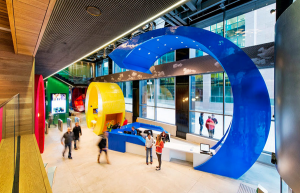 Play is magical. And profound. Not only is it essential to our growth and development when we are children and a source of joy throughout our lives, but it is also a largely untapped channel for innovative ideas in the workplace.
Play is magical. And profound. Not only is it essential to our growth and development when we are children and a source of joy throughout our lives, but it is also a largely untapped channel for innovative ideas in the workplace.
Play is essential to the survival of organizations in a complex and fast-changing marketplace, as it is a key factor in creativity and agility. I have used play to help people become more creative, deal with challenging emotions like self-consciousness or even fear, and regain energy, enthusiasm, and hope when their company was going through difficult times. Play opens the doors to our deeper creative potential, helping us achieve change and implement innovative solutions.
To understand how play works, it’s important to understand what it is. It’s also important to understand what it isn’t. Play isn’t some reprehensible at-risk behavior that threatens to make slackers of us all. Western culture, unfortunately, often sees it that way. Play is perceived to be, at best, a child’s pastime, or an indulgence for the very wealthy or in the worst case, the hallmark of a slacker. Certainly play does not come across as something that serious people in serious businesses should be doing on a daily basis. In fact, play isn’t even necessarily perceived to be beneficial for our children. It is often thought to be more of an at-risk behavior that prevents children from doing more important things.
Dr. Stuart Brown, head of the National Institute for Play, who has extensively researched the functions and purposes of play, believes that one way to overcome negative attitudes toward play is to offer skeptics a view of play that is closer to their comfort zone: the science of play. He says, “Our experiences indicate the executives require sufficient immersion in the science of play before they understand and value it. The intellectual and scientific basis of play can provide the understanding—and permission—to deploy new play-based practices in their organizations. But, they must also value the new practices: without a positive play ethic, the climate for innovation is spoken of as important, but is not acted upon.”
So what is play? Is it the same as fun? Sort of. The key ingredient in play is engagement: engagement within your own mind, with another person, or with an object. Play is always a dynamic experience. Play is really about immersing oneself in a pleasurable activity for the sake of it, with no other particular intent or specific goal. It can be about immersing oneself in reading a book, drawing, sculpting, or fixing a collector’s item such as an antique piece of furniture for the love of restoring a beautiful object. Play can be experienced alone or in a group. In business, observing people play, I have seen the energy in the room immediately become lighter and stronger. Play creates new ways of interactions, allows a different type of bonding, encourages trust among team members, lowers inhibition, and facilitates the production of original ideas because people dare to speak up and express themselves more.
According to theorist and professor Johan Huizinga, play is “free activity standing quite consciously outside ‘ordinary’ life.” He also described it as being “‘not serious’ but at the same time absorbing the player intensely and utterly.”
The National Institute for Play defines play as “a state of being that is intensely pleasurable. It energizes and enlivens us. It eases our burdens, renews a natural sense of optimism and opens us up to new possibilities.” They go on to note, “Scientists—neuroscientists, developmental biologists, psychologists, scientists from every point on the scientific compass—have recently begun viewing play as a profound biological process.” In other words, play is a core aspect of human nature. As such, it needs to be an essential part of work in order to leverage all that people have to offer. When play becomes a key component of a healthy corporate culture, it fosters positive thinking and creative imagination.
If we choose to leave our childish things behind, we not only deny our essential humanity but also cut ourselves off from a tremendous reservoir of creativity with the potential to make us happier and make us more effective contributors at work.





